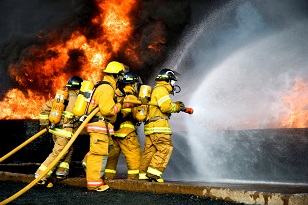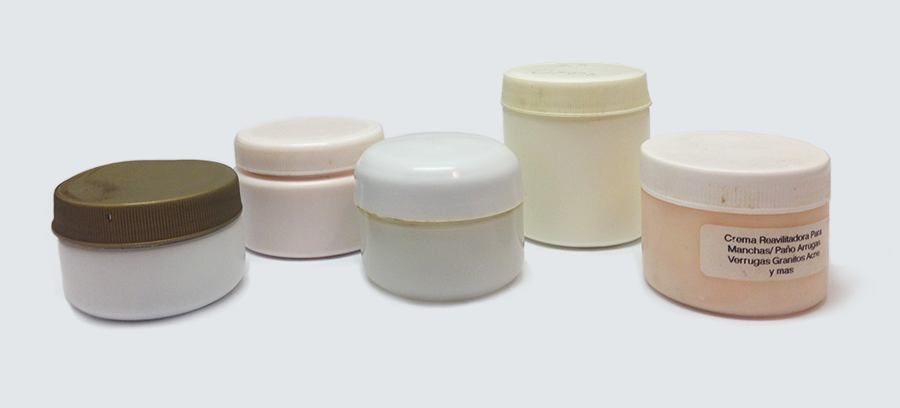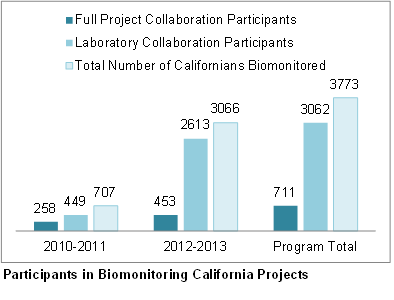 Biomonitoring California is building a robust program with the ability to measure a significant number of chemicals in Californians. We have pursued a variety of collaborative projects that include participants from many different segments of California’s population. Results of these studies can be explored in our online results database. A list of our scientific publications is also available.
Biomonitoring California is building a robust program with the ability to measure a significant number of chemicals in Californians. We have pursued a variety of collaborative projects that include participants from many different segments of California’s population. Results of these studies can be explored in our online results database. A list of our scientific publications is also available.
For the findings described below, links are included to the relevant project page and available publications. Publications are not currently available for all findings. As new scientific articles or reports on these findings are published, we will add links to those items.
Some Key Findings So Far:
Pregnant women and infants
- In a study of pregnant women and their infants in San Francisco, higher levels of some chemicals, including PCBs, organochlorine pesticides, and PBDE flame retardants were found in infants’ cord blood compared to blood samples from their mothers. Exposure to these chemicals may harm the developing fetus and infant, possibly affecting later learning and behavior. A publication on the biomonitoring findings is available.
Firefighters
- High levels of PBDE flame retardants were measured in Southern California firefighters compared to the U.S. general population. The use of personal protective gear and regular cleaning of the gear were associated with lower flame retardant levels. These findings were presented at an international conference and described in a publication.
 Benzophenone-3, a chemical in sunscreen and plastics
Benzophenone-3, a chemical in sunscreen and plastics
Higher levels of benzophenone-3 (BP-3) were measured in Southern California firefighters compared to the general U.S. population. BP-3 is found in sunscreens, many other personal care products and in plastic packaging. BP-3 is suspected of interfering with normal hormone activity. A publication on our findings is available, and highlights of this study are described in a 4 minute audio slide show.
Arsenic in Central Valley residents
- Higher levels of arsenic were found in residents of the Central Valley compared to other California populations and the general U.S. population, based on preliminary results. A publication will be developed when analysis of these results is complete.
Mercury Exposure through Skin-Lightening Cream
- Significantly elevated mercury levels were found in a San Francisco family, which resulted from use of a foreign-made skin-lightening cream adulterated with mercury. Public health investigations have led to the identification of additional cases in California of individuals exposed to mercury from similar creams. The California Department of Public Health has issued alerts to medical providers and fact sheets for consumers regarding skin-lightening products that may contain mercury and other harmful contaminants.
Effectiveness of California Regulatory Efforts
- California’s 2006 ban of PBDE flame retardants is starting to have an impact. In a small follow-up study of pregnant women, in collaboration with UCSF, our laboratory measured a 39% decrease in PBDE levels (three years after the original sampling in 2008-2009). However, Californians continue to have the highest measured PBDE levels in the world because of extensive past use of these flame retardant chemicals and their continued presence in older furniture, electronics and other materials present in homes in California.
Expanded Capability and Capacity:
Chemicals the Program Can Measure
- Biomonitoring California is capable of measuring nearly 140 distinct chemicals or their breakdown products in urine, serum, and whole blood. Many of these chemicals have the potential to adversely impact public health. Having the ability in the state's laboratories to measure these chemicals will help California in its efforts to reduce exposures to specific toxic chemicals.
Number of Participant Samples that have been Collected
Biomonitoring California has obtained specimens from over 3,700 Californians to analyze for chemical contaminants.
Future Directions:
Chemicals of Emerging Concern
- Biomonitoring California is developing laboratory methods for chemicals of emerging concern, including new plasticizers and known replacements for banned flame retardants. These methods, once in place, will allow Biomonitoring California to monitor for and detect increases in exposures to these potential health threats.
Previously Unknown Chemical Contaminants
- Biomonitoring California is developing the capability to detect previously unknown chemical contaminants in people. This will allow the Program to act as an early warning system for new chemical exposures in California and support the state’s innovative regulatory efforts to reduce harmful exposures.





